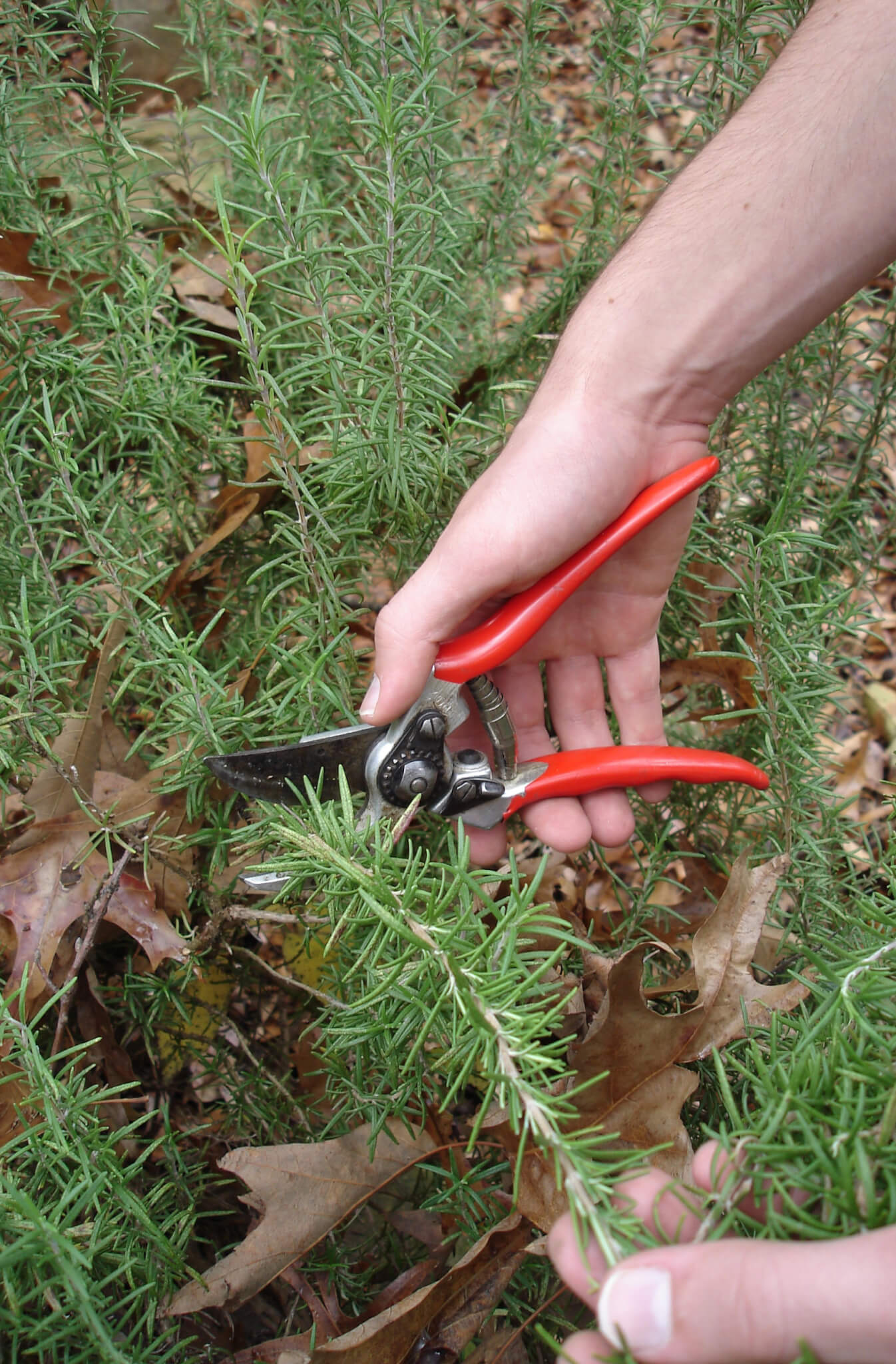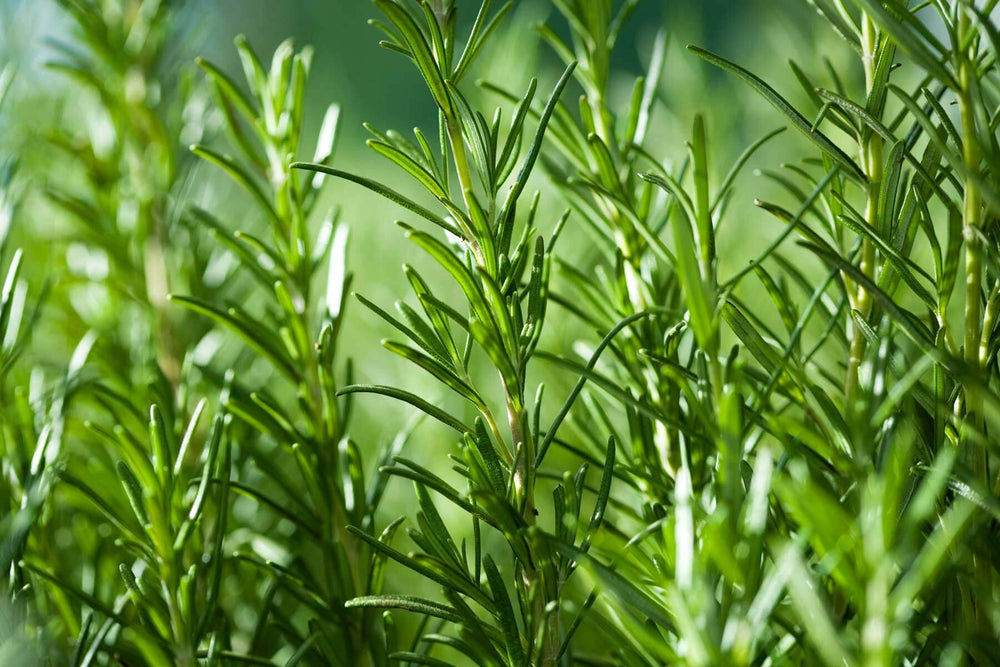Rosemary is a woody-stemmed plant with needle-like leaves that can commonly reach 3 feet in height, eventually stretching to 5 feet in warmer climates unless clipped. In zone 8 and farther south, rosemary bushes make a good evergreen hedge. In zone 7 and colder, try growing rosemary in a container you can bring inside in cold weather. You can even train rosemary into topiary shapes. Plants are tolerant of salt spray, making them a good choice for pots on the beach.

Quick Guide to Growing Rosemary
- Plant rosemary in spring once all chances of frost have passed. This delightful herb is an all-star in the kitchen and is a great option for raised garden beds, containers, and in-ground gardens.
- Space rosemary plants 2 to 3 feet apart in an area with abundant sunlight and rich, well-drained soil with a pH of 6.0 to 7.0.
- Before planting, set your garden up for success by mixing in several inches of aged compost or other rich organic matter into your native soil. For container growing, consider a premium bagged potting mix.
- Promote spectacular growth by feeding rosemary regularly with a water-soluble plant food.
- It's important to water regularly but be sure to let the soil dry out between waterings.
- Harvest rosemary stems by snipping them with sharp gardening shears. Harvest often once the plant is established, but avoid pruning more than one-third of the plant at a time.
Soil, Planting, and Care
Set out rosemary in spring, planting starter plants 2 to 3 feet apart; you can also plant in fall in zone 8 and south. Choose strong, vigorous Bonnie Plants® rosemary to get your garden off to a great start—after all, Bonnie has spent over a century helping home gardeners successfully grow their own food. Plants are slow growing at first, but pick up speed in their second year.
Rosemary prefers full sun and light, well-drained soil with a pH between 6 and 7. Improve your existing soil by adding a few inches of aged compost-enriched Miracle-Gro® Performance Organics® All Purpose In-Ground Soil and mixing it in with the top layer. Potted rosemary needs a lighter-weight soil mix, so fill containers with Miracle-Gro® Performance Organics® All Purpose Container Mix instead. Keep the soil uniformly moist, allowing it to dry out between waterings. Mulch your plants to keep roots moist in summer and insulated in winter, but take care to keep mulch away from the crown of the plant. In the spring, prune dead wood out of the plants.
For best growth, it's not enough just to start with rich, nutritious soil. You'll also want to feed rosemary regularly throughout the season with a plant food that feeds both your plants and the soil, like Miracle-Gro® Performance Organics® Edibles Plant Nutrition (following the directions on the label).
Troubleshooting
Whiteflies, spider mites, scale, and mealybugs can all bother rosemary, as can powdery mildew and root rot, particularly in humid regions. To prevent mildew and rot, be sure your plants enjoy good drainage and air circulation. In zone 7 and northward, extreme cold will kill the tops of the rosemary plant. In areas where it is likely to be hurt by winter, plant in a protected spot such as one near a south-facing masonry wall and away from the prevailing winter wind; also mulch to protect the roots. In zone 8 and farther south, rosemary needs no winter protection.
Harvest and Storage
Cut stems at any time for fresh rosemary. To dry rosemary, use a rack or hang it upside down in bunches to dry. Once stems are dry, strip the leaves from them. You can also freeze rosemary sprigs, preserve them in vinegar, or use them to flavour oil or butter.
Uses
While rosemary blends well with other herbs, use it lightly on its own in lamb, pork, chicken, and veal dishes, as well as in soups and stews, vegetables, and sauces. Rosemary provides a wonderful flavour in breads and makes a good marinade with olive oil, wine, and garlic. Rosemary's aromatic qualities also enhance a bath, bouquet, wreath, or sachet.


FAQs
Will rosemary grow with the other herbs in my herb garden?
Unlike most herbs that live for only one season, rosemary is an evergreen shrub in zone 8 and farther south. For that reason, you should choose a location where it can continue to grow for years to come. It thrives in a sunny, well-drained location where it will reach up to 3 feet tall and wide. You can place it near the gate to your vegetable garden or as part of your home landscape. Because it is so fragrant when touched, it is a nice addition near a sidewalk or porch.
What is rosemary's temperature tolerance?
Our rosemary is dependably hardy in USDA zone 8 and southward, which means in areas in which the temperature does not go below 10 to 15 degrees. If you live in zone 7, plant in a protected location, such as near a south-facing masonry wall, to provide added warmth on cold nights.
Can I trim rosemary anytime, or is there a recommended time?
As with any culinary herb, you should cut fresh, flavorful foliage whenever you need it. Plants do well with a heavy pruning anytime from early spring to midsummer. Try not to cut into stems that are dark and woody; these are less likely to sprout new growth than the younger wood. Remember that rosemary will never have a perfectly round silhouette, because it is the nature of the plant to have upright stems. However, the overall habit of the plant can be thicker with pruning to encourage branching.
I grew rosemary in a large pot and left it out over the winter. Should I cut the plant back or wait for new growth?
Early spring before growth begins is a good time to prune any evergreen, and that includes rosemary. Remove any dead, leafless stems first, and then prune to improve the shape of the plant. Avoid cutting stems that are very old, as they may not sprout new shoots are readily as younger stems. However, if your plant is nicely shaped and you are happy for it to continue growing larger, remember that pruning is not a necessity. Note: when rosemary is grown in a container, do not let it dry to the point of wilting. It may not recover.




 Herbs
Herbs
 Vegetables
Vegetables
 Fruit
Fruit
 Flowers
Flowers
 Succulents
Succulents


